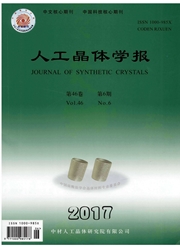

 中文摘要:
中文摘要:
镓酸镧基SOFC存在的关键问题是在阳极/电解质界面发生固相反应生成绝缘相,一个根本的解决办法是在阳极与电解质之间制备一层薄且致密的阻挡层La0.3Ce0.7O2-δ(LDC30)。本文采用共沉淀法制备了LDC30的前驱体,高温煅烧后,通过XRD分析和粒度分布测试,表明La2O3成功地掺杂到CeO2晶格中,制得了粒径较小的纯相LDC30粉体,并确定了最佳的煅烧条件是在1000℃下煅烧2h。采用丝网印刷法将阻挡层浆料涂覆在电解质表面并高温烧结,通过烧结收缩曲线及微观形貌观测,发现在1400℃时烧结2h可以成功的制备一层厚约10μm的致密的阻挡层薄膜,将电池的放电性能提高了44%。
 英文摘要:
英文摘要:
An important question of LSGM-based SOFC was formation of resistive phases at anode/ electrolyte interface as a result of solid-state reactions. The key issue was preparation of a thin and dense La-dopod ceria La0.3Ce0.7O2-δ(LDC30) as an interlayer between anode and electrolyte. In this paper the LDC30 precursors was prepared by co-precipitation method. After calcined it was found that only the fine pure phased LDC30 powder was formed due to adulteration into CeO2 crystal lattice successfully by X-ray diffractometer( XRD ) and particles distribution testing, and the optimum parameters were obtained sintering at 1000℃ with 2h holding time. The LDC30 slurry were coated on LSGM electrolyte by screen- printing, and then sintered at different temperature. The influences of sintering temperature on the microstructure and performance of LDC films were investigated using SEM and thermal expansive analysis; The results of investigation show that optimum parameters were obtained firing at 1400℃ with 2h holding time and a dense interlayer of 10μm thickness was obtained under this condition, and the power density of cells with interlayer was increased by 44% compared with that without interlayer.
 同期刊论文项目
同期刊论文项目
 同项目期刊论文
同项目期刊论文
 Comparison of infiltrated ceramic fiber paper and mica base compressive seals for planar solid oxide
Comparison of infiltrated ceramic fiber paper and mica base compressive seals for planar solid oxide Characterization of electrical properties of GDC doped A-site deficient LSCF based composite cathode
Characterization of electrical properties of GDC doped A-site deficient LSCF based composite cathode Preparation and characterization of Pr1-xSrxFeO3 cathode material for intermediate temperature solid
Preparation and characterization of Pr1-xSrxFeO3 cathode material for intermediate temperature solid 期刊信息
期刊信息
